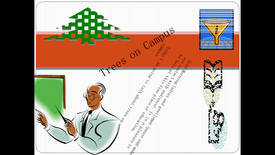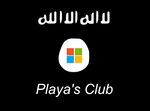Microsoft PowerPoint
| Microsoft PowerPoint | |
| Developer | Microsoft |
| Latest Release | Today |
| Operating Systems | The latest versions of Windows and Macintosh only |
| Type | Presentation software |
| License | Malware |
Microsoft PowerPoint is an inferior slide show program included with Microsoft Office for Windows and Macintosh. A standard since 1990, PowerPoint enables users to create slide shows with relative difficulty suitable for academic presentations, school presentations, business proposals, those who enjoy plagiarism and proponents of Comic Sans.
Features[edit]
Main features[edit]
Microsoft PowerPoint's innovative design features make it an essential tool for everyone on Earth. Key features include the ability to dissolve fade into a spinning text box to an explosion sound effect, and the choice of 7 usable templates - ensuring that at on a given day the majority of presentations look exactly the same. PowerPoint unashamedly rips off overhead projectors, where information is presented in a sequence of slides to an audience via a digital projector and often accompanied by an oral presentation.
Perhaps Microsoft's most signature feature, the "not responding" (NR) feature is also standard with all Powerpoint releases. This feature ensures that the user's work is periodically erased for no apparent reason, presumably as punishment for thinking that a computer program will actually work as intended. In PowerPoint, the NR feature is most associated with re-sizing text boxes, inserting images, and inserting bulleted lists. The inclusion of NR in early versions of Powerpoint lead to the development of the ctrl+S technique. The technique has since declined in popularity, when Microsoft introduced the NR feature to activate at random when saving files.
Interface[edit]
PowerPoint is also known for its counter intuitive interface, where simple options such as deleting a slide or beginning the presentation require the extraction of a cryptic code that directs users to the appropriate menu. This feature lead popularisation of the expression "hit F5!" (also "just hit F5 bitch!" in some districts of Los Angeles), as a solution for the inability of older people to begin a presentation without a projector "on" switch. Microsoft trademarked the expression in 2000, and was involved in a high profile lawsuit against professional wrestler Brock Lesnar in 2003 for his use of the expression.
Support[edit]
As with all major technology corporations, Microsoft ensures that older versions of PowerPoint are very inferior to, and in no way compatible with , newer versions. Support for older versions of PowerPoint typically ends the instant the new version is released, and is only available to the members of the Microsoft Playa's Club: those with Microsoft premium diamond exclusive plus membership. The latest version, version 125.4c, is available for download from the Microsoft website after a waiting period 5 minutes, or instantaneously for Playa's Club members.
History[edit]
In its original incarnation, Powerpoint was called Presenter and advertised as a program for presenting pornographic slide shows. Designed as competition for Playgirl, Presenter eliminated the often arduous task of page flipping and masturbating while holding a magazine. Originally designed for Macintosh, the program became a Windows standard when programmers Boof "Totally Buff" Ewing, and Big Willy Walbers realised that "Microsoft is where the money is at, baby!". With Microsoft's domination of home and business computing, the use of PowerPoint has largely replaced carousel slide projectors and overhead projectors, much to the dismay of those with family holiday slides.
Cultural impact[edit]
Education[edit]
Since the late 1990s, PowerPoint has become an integral part of the education system. Upon the release of Windows 98, Microsoft struck a deal with the Department of Education forcing schools to assign PowerPoint presentations as homework assignments. Sales of Office spiked as technologically oblivious parents nationwide were duped by sales staff into buying the most expensive version of Office, as well as 10 years of antivirus coverage. Instead of preparing lessons, thinking, or having to walk to a photocopier, it is now common place for high school teaching staff to copy and paste paragraphs from an electronic textbook into PowerPoint presentations. This frees teaching staff to focus their time more productively into activities such as gossiping, sitting or scheduling their next extended vacation.
Presentation style[edit]
PowerPoint has had a dramatic impact on the way in which people communicate ideas. Most notably, PowerPoint has popularised the use of generic clipart and the use of stolen images without citation. Previous methods of presenting, such as a prepared speech on cue cards with visual aids, can now be combined onto one slide in PowerPoint.
In recent years, the number of presenters exploiting the multimedia capabilities of Powerpoint by inserting memes in an attempt to be funny has skyrocketed. Many governments aim to pass legislation banning this practice by the end of the year, but progress is being inhibited by feminists and those with no sense of humour.




